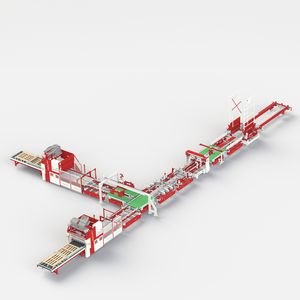
- Production Machines
- Other Manufacturing Equipment
- Pallet nailing machine
- Stoeri Mantel, s.r.o.
- Company
- Products
- Catalogs
- News & Trends
- Exhibitions
Pallet nailing machine


Add to favorites
Compare this product
Characteristics
- Type
- pallet
Description
The machine is designed for nailing 2-way and 4-way single and double-operation pallets. Standardly, the machine is equipped with universal templates, with the first serving to perform the first operation and the second template for finalizing the pallet nailing. The nailing process itself operates on the principle of electromechanical drive (two linear actuators) with minimal electrical energy consumption. The nailing machine can work independently or can be integrated into an automatic palletizing line with pallet processing and stacking. Two operators manage the machine operation.
What types of pallets can you nail?
- Nailing of two-way and four-way pallets.
- For single-operation and two-operation pallets
A single-operation pallet, or all its parts, are manufactured in the same nailing cycle.
A two-operation pallet has a construction that requires two different nailing cycles, or two operations, for its complete production. It cannot be made on a standard single-operation machine. Each operation uses different nailing hammers.
What is the capacity and serviceability of the nailing machine?
- The capacity of the two-operation nailing machine is 400-450 pcs / shift (8 hours).
- The machine is operated by two workers.
What dimensions of pallets can be manufactured?
Universal template (basic equipment)
- This template can manufacture various types of pallets, thanks to simple readjustment using an Allen key. The basic configuration is set according to customer's wish, or for a classic pallet construction (e.g., EUR).
- Pallet width 600 mm - 1200 mm (optionally up to 1500 mm)
VIDEO
Catalogs
No catalogs are available for this product.
See all of Stoeri Mantel, s.r.o.‘s catalogsOther Stoeri Mantel, s.r.o. products
Machines for pallet production
*Prices are pre-tax. They exclude delivery charges and customs duties and do not include additional charges for installation or activation options. Prices are indicative only and may vary by country, with changes to the cost of raw materials and exchange rates.












